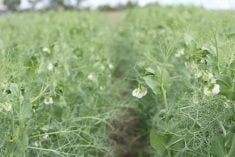Soft white spring wheat producers are pumped about a large new market for Canada’s smallest class of wheat.
“Certainly we have a very big opportunity as far as ethanol is concerned,” said Andy Kovacs, executive director of the Alberta Soft Wheat Producers Commission.
Soft white wheat is ideally suited to the burgeoning biofuel sector. Under irrigation it will produce up to 140 bushels per acre. Dryland yields top out at about half that amount.
In addition to its impressive yields, the grain is high in starch and low in protein, which is exactly what ethanol plants want.
Read Also

Phosphate prices to remain high
Phosphate prices are expected to remain elevated, according to Mosaic’s president.
Kovacs said the class has already made a name for itself at Pound-Maker Agventures Ltd., Canada’s first integrated feedlot-ethanol facility, in Lanigan, Sask.
“They virtually converted all of their production from CPS reds and whites … to soft white spring and basically to AC Andrew,” he said.
AC Andrew is by far the most popular and highest yielding line, accounting for 69 percent of soft white spring wheat production in 2005.
Kovacs said the variety has attracted the attention of Husky Energy, which is building two new ethanol plants, each capable of producing 130 million litres of the fuel per year. The first will be built in Lloydminster, Sask., the second in Minnedosa, Man.
Once its two plants come on stream, Husky will become the largest buyer of feed wheat in Western Canada, consuming 700,000 tonnes of feed grain annually. The company said it is looking for high yielding wheat varieties containing a high starch content.
Growers planted 53,000 acres of soft white spring wheat this year – 35,000 in Alberta, 10,000 in Saskatchewan and 8,000 in Manitoba.
“I see these numbers, not in Alberta, but certainly in Saskatchewan and Manitoba, probably doubling each year starting now,” said Kovacs.
Alberta is expected to produce at least 100,000 tonnes of the crop on about 50,000 acres of irrigated land in 2007, taking the Western Canada total to an estimated 86,000 acres, which would be a 79 percent increase over the five-year average for the crop.
Ethanol isn’t the only factor behind the anticipated expansion. Soft white wheat has found new markets with maltsters and whisky distillers as well, providing new outlets for a class of wheat that until recently had primarily been produced for the pastry market.
“That market is pretty static and pretty limited. It is not growing,” said Kovacs.
Agriculture Canada wheat breeder Rob Graf agreed that the future looks promising for soft white wheat. He, too, expects increased acreage next year.
“There will be some real interest in Andrew as we are already seeing,” he said.
And there are a couple of new varieties in the pipeline that produced yields of 170 bu. an acre in co-op field trials near Bow Island, Alta., this year. If all goes well they should be available to growers in two years.
“We’ve got a couple coming through the co-op right now that look very promising,” said Graf.
The target is to develop a new line that will produce 200 bu. per acre under irrigated production, which would greatly increase producer revenues.
Breeders are also incorporating improved leaf and stem rust resistance into soft white varieties, so they can be grown in Manitoba with minimal risk.
Also, they are working on lines specifically developed for the ethanol industry. Those varieties could be commercially available in about five years.
The domestic ethanol market could cut into the amount of soft white wheat that the Canadian Wheat Board handles, since those sales would be outside of the board’s monopoly.
CWB spokesperson Maureen Fitzhenry said the board is encouraged that farmers could soon have a new outlet for their wheat.
“By the same token no one should lose sight of the fact that Western Canada’s strong suit is its high quality milling wheat,” she said.















